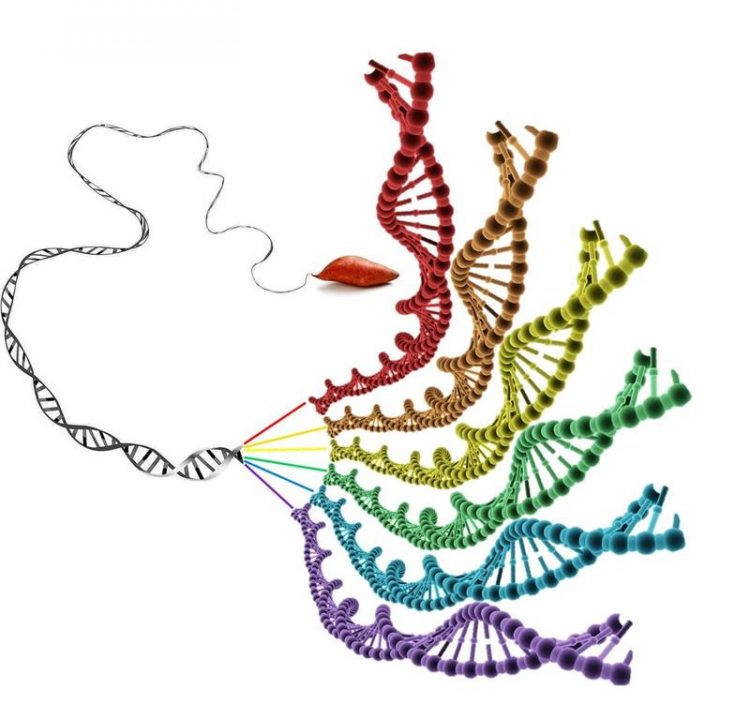The sweet potato and it´s evolutionary traces

The hexaploid sweet potato has six copies of each chromosome. Jun Yang
Besides the research in model plants like Arabidopsis thaliana, studies in crop plants is focused by many scientists worldwide. Goals are to gain basic knowledge about different plants as well as reaching breeding aims like the improvement of yield or a higher resistance against changing environmental conditions. In regard to the growing world population these aims are important steps for future food assurance.
The unraveling of the plant genome is the first step for a better understanding. Some of Germany´s most important crop plants are potato and wheat which hence are both well studied and characterized. Within the following study a better understanding of another important crop plant was achieved.
Researchers from five different research institutes in China and Germany were able to sequence the complete genome of the sweet potato Ipomoea batatas. This plant belongs to the family Convolvulaceae and with a production of more than 100 million tons being the seventh most important crop in the world and the fourth most significant crop of China.
In advance it was already predicted that the sweet potato, having 90 chromosomes and being a hexaploid organism, would be no easy species for a complete sequencing project. The amount of chromosomes is high compared to many other plants but the phenomenon of polyploidy can be found as well in many other plants as for example in the hexaploid wheat.
Polyploidy is characterized by having more than a normal diploid set of chromosomes (2n) in the genome, in the case of sweet potato and wheat each homologous chromosome is present six times. How is a duplication of chromosomes possible and what is the result for the plants which is affected?
A whole-genome duplication event can be caused by an incorrect separation of the chromosomes within the meiosis phase. Reasons for this malfunction are manifold and can include spontaneous mutations, poison or even just environmental conditions like cold. The impact of such a polyploidization event can be severe and even lethal. Nevertheless in plant species this phenomenon can be as well neutral or positive and lead to an accelerated evolution.
A remarkable example can be found in the evolution of wheat since the hexaploid durum wheat (6n) arose from the diploid einkorn wheat (2n). This was possible by spontaneous crosses of the einkorn wheat with several diploid wild grasses which accumulated the chromosome number up to the current hexaploid state in the durum wheat.
In the current issue of Nature Plants the researchers show that the nowadays sweet potato has gone through a similar evolution 500.000 years ago. Ancestors have been a diploid and a tetraploid plant which cross lead to the hexaploid Ipomoea batatas. They developed a novel haplotyping method with which they are able to predict the origin of the single chromosomes.
Furthermore they could show that quite a number of genes have accumulated deleterious mutations on different alleles. This leads to the assumption that the selection pressure on the redundant chromosomes is much lower and hence that the ploidization event can drive an evolutionary advantage. In other words: due to the existence of six instead of two copies of the genome the accumulation of deleterious mutations is without a negative impact for the sweet potato.
Contact
Prof. Alisdair Fernie
Max Planck Institute of Molecular Plant Physiology
Phone +49331/567 8211
fernie@mpimp-golm.mpg.de
Dr. Jana Dotzek and Dr. Ulrike Glaubitz
Public Relations Officers
Max Planck Institute of Molecular Plant Physiology
Phone +49331/567 8211
pr@mpimp-golm.mpg.de
http://www.mpimp-golm.mpg.de
Jun Yang, M-Hossein Moeinzadeh, Heiner Kuhl, Johannes Helmuth, Peng Xiao, Stefan Haas, Guiling Liu, Jianli Zheng, Zhe Sun, Weijuan Fan, Gaifang Deng, Hongxia Wang, Fenhong Hu, Shanshan Zhao, Alisdair R Fernie, Stefan Boerno, Bernd Timmermann, Peng Zhang & Martin Vingron. Haplotype-resolved sweet potato genome traces back its hexaploidization history. Nature Plants, 2017; DOI: 10.1038/41477-017-0002.
Media Contact
All latest news from the category: Life Sciences and Chemistry
Articles and reports from the Life Sciences and chemistry area deal with applied and basic research into modern biology, chemistry and human medicine.
Valuable information can be found on a range of life sciences fields including bacteriology, biochemistry, bionics, bioinformatics, biophysics, biotechnology, genetics, geobotany, human biology, marine biology, microbiology, molecular biology, cellular biology, zoology, bioinorganic chemistry, microchemistry and environmental chemistry.
Newest articles

Properties of new materials for microchips
… can now be measured well. Reseachers of Delft University of Technology demonstrated measuring performance properties of ultrathin silicon membranes. Making ever smaller and more powerful chips requires new ultrathin…

Floating solar’s potential
… to support sustainable development by addressing climate, water, and energy goals holistically. A new study published this week in Nature Energy raises the potential for floating solar photovoltaics (FPV)…

Skyrmions move at record speeds
… a step towards the computing of the future. An international research team led by scientists from the CNRS1 has discovered that the magnetic nanobubbles2 known as skyrmions can be…





















